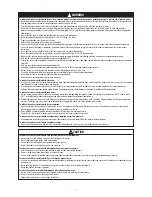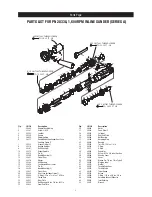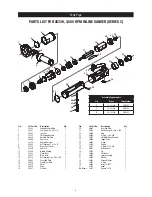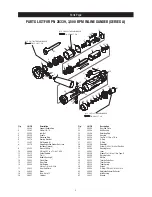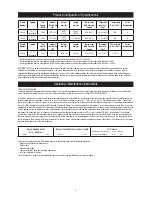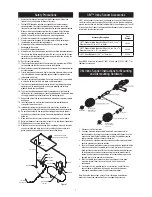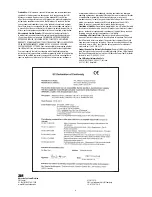
1
2
To reduce the risks associated with impact from abrasive product or tool breakup, sharp edges, hazardous pressure, rupture, vibration and noise:
• Read, understand and follow the safety information contained in these instructions prior to the use of this tool. Retain these instructions for future reference.
• Only personnel who are properly trained should be allowed to service this tool.
• Practice safety requirements. Work alert, have proper attire, and do not operate tools under the influence of alcohol or drugs.
• Operators and other personnel must always wear protection for eyes, ears, and respiratory protection when in the work area or while operating this
product. Follow your employer’s safety policy for PPE’s and/or ANSI Z87.1 or local/national standards for eyewear and other personal protective equipment
requirements.
• Wear protective apparel, taking into consideration the type of work being done.
• Never exceed marked maximum input pressure (90 psi / .62 Mpa / 6.2 Bars).
• Proper eye protection must be worn at all times.
• Tool shall not be operated in the presence of bystanders.
• If you notice any abnormal noise or vibration when operating the product, immediately discontinue its use and inspect for worn or damaged components.
Correct or replace the suspect component. If abnormal noise or vibration still exists, return the tool to 3M for repair or replacement. Refer to warranty
instructions.
• Never operate this tool without all safety features in place and in proper working order.
• Never over-ride or disable the safety features of the start-stop control such that it is in the on position.
• Make sure the tool is disconnected from its air source before servicing, inspecting, maintaining, cleaning, and before changing abrasive product.
• Only use abrasive accessories and other accessories supplied by 3M.
• Prior to use, inspect abrasive product and other accessories for possible damage. If damaged, replace with new abrasive product and accessories available
from 3M.
• Only use accessories supplies or recommended by 3M.
• Use only with mounting hardware recommended by 3M; check with 3M for mounting hardware requirements.
• Always insure that mating accessory diameters and/or threads properly match that of tool.
• Use only with abrasive products not requiring guards according to local, state and federal regulations.
• Never allow this tool to be used by children or other untrained people.
• Do not leave an unattended tool connected to air source.
To reduce the risks associated with vibration:
• If any physical hand/wrist discomfort is experienced, work should be stopped promptly to seek medical attention. Hand, wrist and arm injury may result from
repetitive work, motion and overexposure to vibration.
• If the operator experiences symptoms such as persistent or recurring discomfort, pain, throbbing, aching, tingling, numbness, burning sensations or
stiffness, these warning signs should not be ignored. The operator should tell the employer and consult a qualified health professional.
To reduce the risks associated with loud noise:
• Always wear protection for eyes, ears, and respiratory protection while operating this product. Follow your employer’s safety policy for PPE’s and/or ANSI
Z87.1 or local/national standards for eyewear and other personal protective equipment requirements.
• Exposure to high noise levels can cause permanent, disabling hearing loss and other problems, such as tinnitus (ringing, buzzing, whistling or humming in
the ears). Therefore, risk assessment and implementation of appropriate controls for these hazards are essential.
To reduce the risks associated with fire or explosion:
• Do not operate the tool in explosive atmospheres, such as in the presence of flammable liquids, gases, or dust. The abrasives are able to create sparks
when working material, resulting in the ignition of the flammable dust or fumes.
• Refer to MSDS of material being worked as to potential for creating fire or explosion hazard.
• There is a risk of electrostatic discharge if used on plastic and other non-conductive materials.
To reduce the risks associated with hazardous dust ingestion or eye/skin exposure:
• Use appropriate respiratory and skin protection, or local exhaust as stated in the MSDS of the material being worked on.
To reduce the risks associated with hazardous voltage:
• Do not allow this tool to come into contact with electrical power sources as the tool is not insulated against electrical shock.
WARNING
CAUTION
To reduce the risks associated with skin abrasion, burns, cuts, or entrapment:
• Keep hands, hair, and clothing away from the rotating part of the tool.
• Wear suitable protective gloves while operating tool.
• Do not touch the rotating parts during operation for any reason.
• Do not force tool or use excessive force when using tool.
To reduce the risks associated with whipping or hazardous pressure-rupture:
• Ensure supply hose is oil resistant and is properly rated for required working pressure.
• Do not use tools with loose or damaged air hoses or fittings.
• Be aware that incorrectly installed hoses and fittings might unexpectedly come loose at any time and create a whipping/impact hazard.
To reduce the risks associated with fly off of abrasive product parts:
• Use care in attaching abrasive product and mounting hardware; following the instructions to ensure that they are securely attached to the tool before use or
free-spinning.
• Never point this product in the direction of yourself or another person, or start tool unintentionally.
• Never over-tighten accessory fasteners.
To reduce the risk associated with improperly inflated pneumatic wheel:
• Always inflate the pneumatic wheel to sufficient pressure to properly retain the abrasive product.
• Do not over-inflate or under-inflate pneumatic wheel.
• Follow wheel manufacturer’s instructions for inflation.


